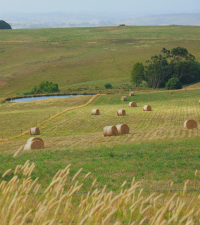Upcycled Food & Regenerative Ag: Allies in Systems Change for a Circular Economy
February 23, 2022

The following is a guest contribution by Dan Kurzrock, Co-Founder & CEO of ReGrained.
Over one-third of the food in the United States is lost or wasted every year, squandering natural resources, contributing to food insecurity, and perpetuating the climate crisis. Of the 73 to 152 million metric tons of measured food waste lost each year, the most wasted foods are fruits and vegetables, followed by dairy and eggs. Over half of all waste occurs at households and restaurants, while the food distribution and processing (i.e., manufacturers) sector generates 34 million metric tons of the total amount stated above.
Put in terms of gross tonnage, it’s the equivalent of every U.S. citizen wasting over 1,000 pounds of food each year.
As the adage goes, you can’t manage what you don’t measure, and there have been over a dozen studies attempting to quantify the impact on natural resources and required inputs to produce food that is never consumed. In November 2021, the U.S. Environmental Protection Agency published an exhaustive 107-page report titled, “From Farm to Kitchen: The Environmental Impacts of U.S. Food Waste.” The study conducted a systemic review of relevant peer-reviewed reports and other publicly available information pertinent to food loss and waste from 2010 through 2020, with priority given to publications from 2014 or later. Even to the initiated, the findings are staggering.
Approximately 16% of agricultural land, a footprint the size of California and New York combined, is dedicated to producing crops that are never eaten each year.
Similarly, we’re wasting 20% of our food system’s (largely fossil-fuel reliant) energy consumption, which is enough to power 50 million homes (Figure 1). Our current food system is linear and extractive – we take, we make, and we waste. Breaking our destructive cycle of waste by redesigning for circularity is arguably the lowest hanging-fruit dangling within humanity’s reach. In contrast to linear thinking, a circular economy stops waste from happening in the first place.

Breaking the cycle and reframing the system requires intention and commitment by all stakeholders—from farmers and food manufacturers to retailers and consumers. The good news? Doing so is in everyone’s best interest.
As The Ellen MacArthur Foundation in its groundbreaking report, “The Big Food Redesign: Regenerating Nature with the Circular Economy” so aptly asserts, the circular design of food makes it possible to transform our food system into one that is good for people, planet, and the prosperity of all stakeholders. The report brilliantly creates a framework that combines food design with the principles of the circular economy. These three principles include:
- Eliminate waste and pollution
- Circulate products and materials at their highest value (i.e., upcycled ingredients)
- Regenerate nature (e.g., regenerative agriculture, agroecology, agroforestry)
But what exactly does “food design” mean? The discipline entails developing (or reformulating) products to have nature-positive outcomes, with profitability typically as a co-benefit. With food design, we seize the opportunity to collectively look at ingredient ecosystems to understand a product’s impact on the environment, and then adjust our inputs to yield more optimal outputs. Increasing ingredient diversity is a central tactic to circular food design.
Today, just four crops provide 60% (!) of the world’s calories, while many alternative ingredients that pack a lighter environmental load (and potentially greater benefits) are rarely used.
For instance, consider the development of mainstream food products designed to replace a percentage of conventional wheat with regeneratively farmed perennial grains like Kernza and/or upcycled brewers’ grains. Perennial grains support regenerative agriculture by building healthy soils, improving wildlife habitats, and protecting water resources. Upcycled brewers’ grains yield an entirely second product, where there was previously just one.
When it comes to sourcing ingredients, food processors that embrace circular design provide significantly greater benefits than only improving conventional sourcing practices. As seen in Figure 2, these benefits positively affect people and planet, by improving biodiversity and lowering GHG emissions, while simultaneously driving greater economic return. HowGood was built as a tool to help food companies gain deep data insights and access this trove of triple-bottom-line opportunities.

Upcycled ingredients are central to the circular design framework to ensure food reaches its highest use and maximizes the return on the resources that have already been exhausted (Figure 2). According to the Upcycled Food Association (UFA), “Upcycled foods use ingredients that otherwise would not have gone to human consumption, are procured and produced using verifiable supply chains, and have a positive impact on the environment.” Upcycling transforms cost and risk into upside and opportunity. From fruit pulp/pits and baby carrot shavings to whey from yogurt and grain from breweries, the food supply chain is leaving a vastly underappreciated amount of edible and nutritious food sources off the table.

Unsurprisingly, upcycling is recognized as a top food waste solution for food producers in terms of economic and environmental impact.
According to ReFED’s aggregated analysis, food waste diverted with upcycling eliminates 2.6 metric tons of CO2e and saves 238,000 gallons of water saved per ton.
To bolster credibility for upcycled foods, the UFA introduced the Certified Upcycled® standards in 2021. The standard was developed with a cross-sectoral committee of expert stakeholders and is administered in cooperation with Where Food Comes From, Inc., the leading resource for independent, third-party verification of food production practices in North America. The certification is an important tool to enable the market to delineate between the vanguards of authentic impact and the “vultures.” The purpose of the standard is to deliver transparency and earn trust with consumers and the trade, protecting the veracity of environmental, societal, and governance (ESG) product claims.
Trust is priceless, but the return is still measurable: 54% of consumers surveyed in a leading study indicated that the UFA certification mark increased their purchase intent. The certification does not currently provide environmental net-impact reporting but takes an important step by ensuring certified products and ingredients are a) genuinely sourced from food loss destinations, b) accounting for operational carbon emission sources, and c) preventing food waste internally.
Upcycling is a promising food waste solution. Hundreds of companies are developing brands, products, and supply chains. Respected organizations, media, and investor community echo support. Yet, consumer demand for these products is ultimately most crucial to the success of upcycled food supplies and reducing food waste overall.
At a macro level, 42% of consumers report an increased awareness of the environmental impact their food choices represent. Further, a leading study found that 95% of consumers surveyed indicated a specific desire to do their part to reduce food waste. Another study found that consumer consciousness of the positive impact food waste mitigation has on the climate crisis has grown 71% since 2019.
Together, these data points demonstrate an active interest by consumers (including you, dear reader) to make food choices that reduce their food waste and help improve the planet’s health.
In this context, food choices may include buying less food to avoid spoilage, selecting brands that support regenerative farming practices, choosing items made with certified upcycled ingredients, or all of the above.
The COP26 Summit, just the latest in an ongoing series of global calls to action, sent a clear message that the time for urgent action is now. The food system is a significant contributor to climate change, and our business leaders play a critical role to develop solutions and lead the way for all stakeholders. The circular design of food is a compelling framework for food companies to implement because it marries nature-positive solutions with economic upside.
Folks, it is time for bold action to put theory into practice. The analysis is done, now it is up to us to choose agency over paralysis.



.png)
